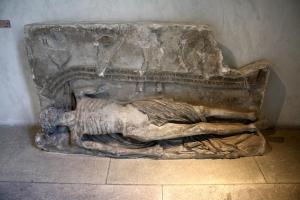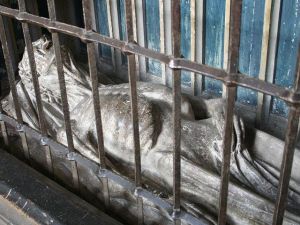
Marble fragment from the tomb of Cardinal Jean de La Grange from the apse of the church of the Benedictine College of St. Martial, (c.1388-1402 CE), Musee du Petit Palais, Avignon, France.
Transi tombs first appeared in Europe as a widespread phenomena in the late Medieval period. They are sculptural depictions of decaying bodies which frequently include other organisms (worms or rats for example) depicted devouring the rotting flesh of the main figure. The word ‘transi” in Latin literally means “to pass.” These strange monuments fall into the category of cadaver tombs, but they are a distinct category within this larger definition, because tombs depicting skeletons or the likeness of the deceased wrapped in a shroud also fall into the category of “cadaver tombs.” One of the most familiar transi tombs is the tomb of Cardinal Jean de La Grange, from the apse of the church of the Benedictine College of St. Martial in Avignon, France. It was sculpted from about 1388-1402, and represents a classic example of the transi.
There are two major events which shocked the Medieval world in the 1300’s; the Black Death and the Great Famine. The Black Death is still a morbidly popular, well known and taught topic today in a global world which has a heightened consciousness and fear of epidemics. But the Great Famine, which occurred just before the spread of the plague, and certainly contributed to weakened immune systems, is rarely talked about. It had an impressive death toll on it’s own, with conservative estimates stating that the famine caused the death of at least 15% of the Northern European population.
Life for the average Medieval person was rough; the vast majority of every population in Europe were farmers, and the skeletons exhumed from rural Medieval graves display an almost universal affliction of severe osteoarthritis, bone deformation, and eburnation. Most of the day for farmers was spent bent at the waist tending to fields. Peasants were chronically undernourished, as the total caloric expenditure created by their vigorous life style is equivalent to someone who today is training for the olympic games (for more information on the Great Famine see The Third Horseman, by William Rosen).
The Great Famine was essentially caused by a massive shift in the normal patterns of warm weather which had occurred between approximately 800 and 1315 CE, usually referred to as the Medieval Warm Period (MWP). The change in weather caused a shortage of food and created a surplus of excruciating death unlike anything that had ever been seen in those times. The rain lasted for days without stopping, one English chronicle states that the rain did not stop anywhere in Europe north of the Pyrenees for over 150 days! Countless writers of the time cite the extreme measures to which people went to acquire food, from marauding to cannibalism. “Men and women furtively ate their children… (while) jailed thieves… devoured themselves (see the chronicle written in Johannes de Trokelowe’s Annales).” The Great famine visited death on Medieval people in many forms, aside from starvation, during which the body literally eats itself, dissolving bone and skeletal muscle, causing cellular autophagy, and finally death by suffocation as the lungs shut down, but also lowering the immune system significantly. Famines cause a spike in diseases such as measles, tuberculosis, amoebic and bacterial dysentery, intestinal parasites, cholera, and herpes, to name but a few.
The familiarity with the slow decay of starvation brought about by the Great Famine is what motivated the nobility’s change in grave monument sculpture. These transi monuments also attest to the widespread effects of the famine in the mentality of late Medieval peoples. The damage was so extensive that even the highest levels of the social hierarchy were massively affected and made painfully familiar with death. The transi are relegated almost exclusively to the north of Europe; the area most effected by the Great Famine. The rendering of the decaying flesh suggests not only a familiarity with the dead, but a very close one-on-one observation of the dead by the artist.
The vast majority of dead in the 1300’s lay in the street for days on end before crews of laborers could pile them onto carts and deposit them in mass graves. The rate of death turned European burial into a very democratic practice. Therefore the ability to provide a private burial, and more, to commission a sculptor to create an elaborate monument, was a privilege reserved for only the most wealthy of society. The transi tomb represents the inescapable infiltration of starvation into the very upper echelon of society.
Here are some other examples of transi tombs:


Pingback: Medieval Coffins: Naked Burials | Sight+Signs